Analysis of Leadership and Operations Management at Toyota Company
VerifiedAdded on 2020/10/22
|13
|3309
|154
Report
AI Summary
This report examines the leadership and operations management practices of Toyota, a leading automobile manufacturer. It differentiates between the roles and characteristics of leaders and managers within the company, exploring their responsibilities in various contexts, including conflict resolution and timely product delivery. The report delves into different leadership theories such as situational and contingency leadership, and analyzes key approaches to operations management including Just in Time, Six Sigma, and Lean Production. It also discusses the roles and responsibilities of managers within operational functions like finance and operations, and identifies factors that impact operational decision-making. This comprehensive analysis offers valuable insights into how Toyota manages its operations and achieves its business objectives.
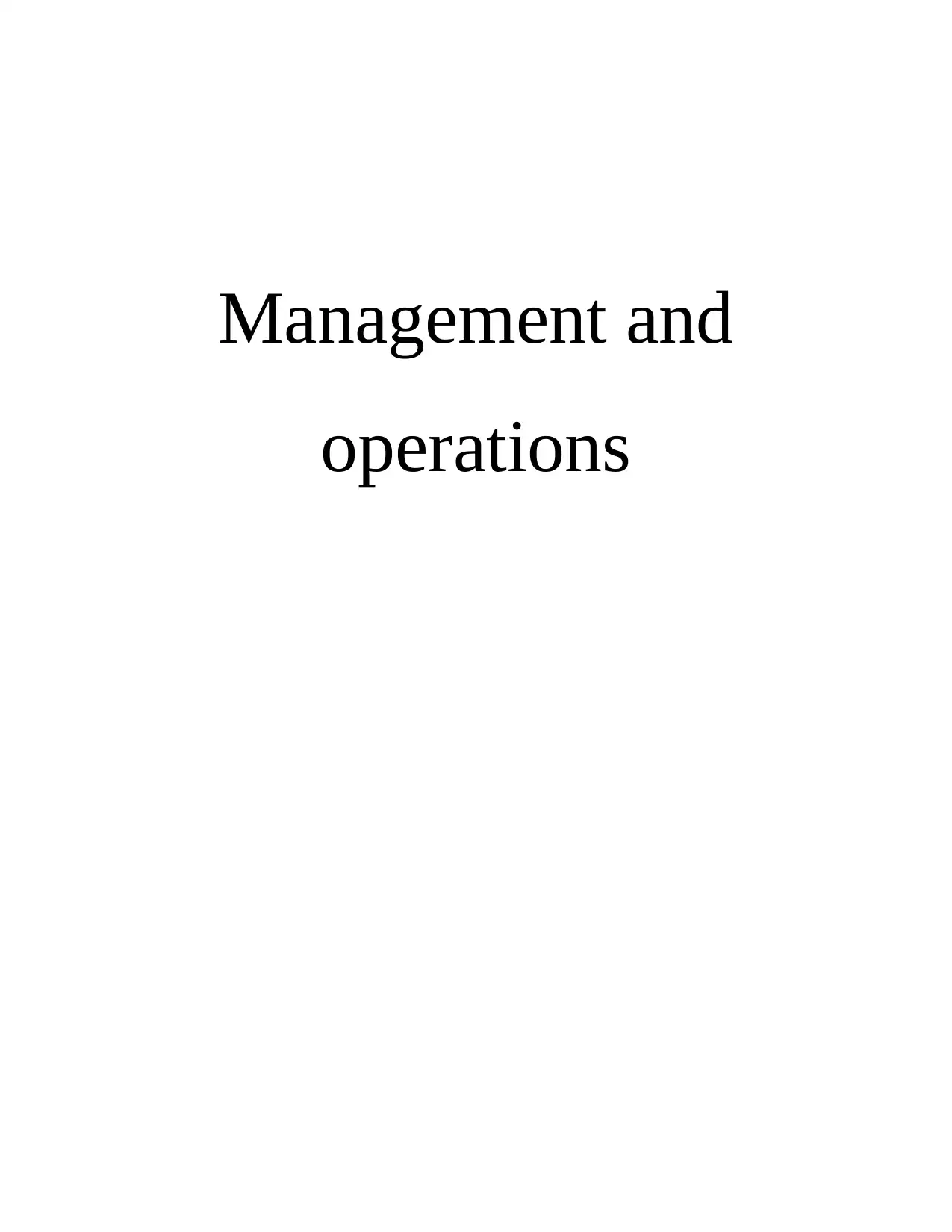
Management and
operations
operations
Paraphrase This Document
Need a fresh take? Get an instant paraphrase of this document with our AI Paraphraser

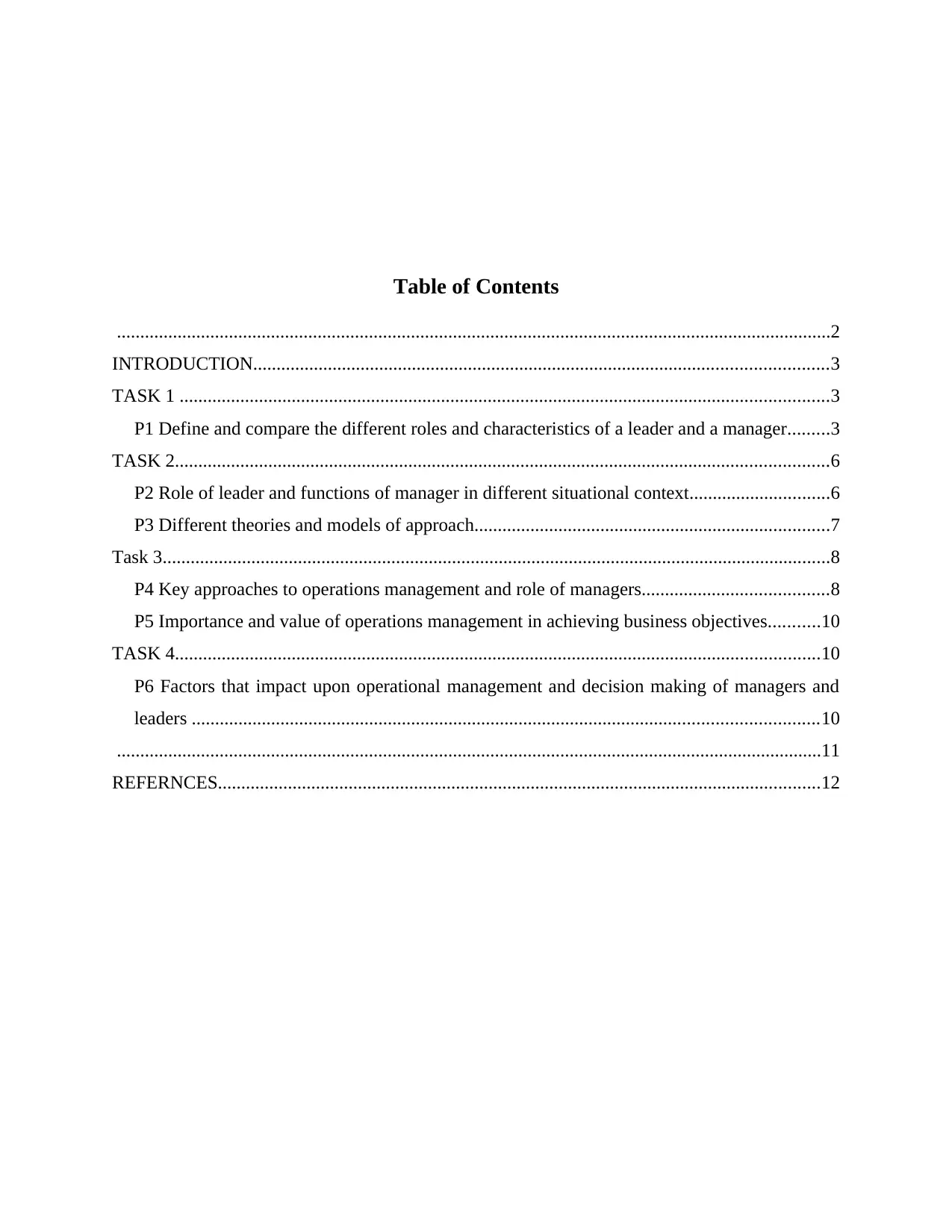
Table of Contents
.........................................................................................................................................................2
INTRODUCTION...........................................................................................................................3
TASK 1 ...........................................................................................................................................3
P1 Define and compare the different roles and characteristics of a leader and a manager.........3
TASK 2............................................................................................................................................6
P2 Role of leader and functions of manager in different situational context..............................6
P3 Different theories and models of approach............................................................................7
Task 3...............................................................................................................................................8
P4 Key approaches to operations management and role of managers........................................8
P5 Importance and value of operations management in achieving business objectives...........10
TASK 4..........................................................................................................................................10
P6 Factors that impact upon operational management and decision making of managers and
leaders ......................................................................................................................................10
.......................................................................................................................................................11
REFERNCES.................................................................................................................................12
.........................................................................................................................................................2
INTRODUCTION...........................................................................................................................3
TASK 1 ...........................................................................................................................................3
P1 Define and compare the different roles and characteristics of a leader and a manager.........3
TASK 2............................................................................................................................................6
P2 Role of leader and functions of manager in different situational context..............................6
P3 Different theories and models of approach............................................................................7
Task 3...............................................................................................................................................8
P4 Key approaches to operations management and role of managers........................................8
P5 Importance and value of operations management in achieving business objectives...........10
TASK 4..........................................................................................................................................10
P6 Factors that impact upon operational management and decision making of managers and
leaders ......................................................................................................................................10
.......................................................................................................................................................11
REFERNCES.................................................................................................................................12
⊘ This is a preview!⊘
Do you want full access?
Subscribe today to unlock all pages.

Trusted by 1+ million students worldwide
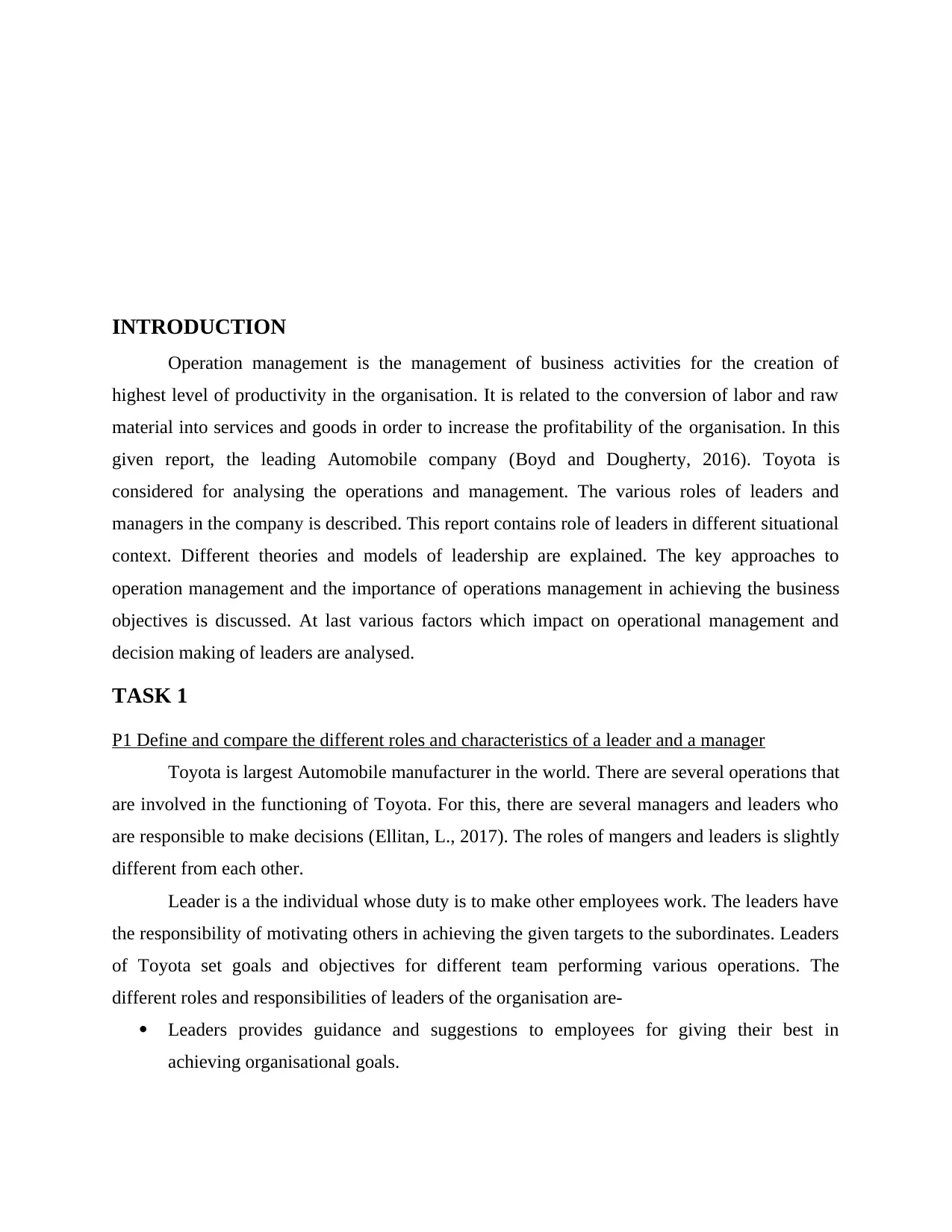
INTRODUCTION
Operation management is the management of business activities for the creation of
highest level of productivity in the organisation. It is related to the conversion of labor and raw
material into services and goods in order to increase the profitability of the organisation. In this
given report, the leading Automobile company (Boyd and Dougherty, 2016). Toyota is
considered for analysing the operations and management. The various roles of leaders and
managers in the company is described. This report contains role of leaders in different situational
context. Different theories and models of leadership are explained. The key approaches to
operation management and the importance of operations management in achieving the business
objectives is discussed. At last various factors which impact on operational management and
decision making of leaders are analysed.
TASK 1
P1 Define and compare the different roles and characteristics of a leader and a manager
Toyota is largest Automobile manufacturer in the world. There are several operations that
are involved in the functioning of Toyota. For this, there are several managers and leaders who
are responsible to make decisions (Ellitan, L., 2017). The roles of mangers and leaders is slightly
different from each other.
Leader is a the individual whose duty is to make other employees work. The leaders have
the responsibility of motivating others in achieving the given targets to the subordinates. Leaders
of Toyota set goals and objectives for different team performing various operations. The
different roles and responsibilities of leaders of the organisation are-
Leaders provides guidance and suggestions to employees for giving their best in
achieving organisational goals.
Operation management is the management of business activities for the creation of
highest level of productivity in the organisation. It is related to the conversion of labor and raw
material into services and goods in order to increase the profitability of the organisation. In this
given report, the leading Automobile company (Boyd and Dougherty, 2016). Toyota is
considered for analysing the operations and management. The various roles of leaders and
managers in the company is described. This report contains role of leaders in different situational
context. Different theories and models of leadership are explained. The key approaches to
operation management and the importance of operations management in achieving the business
objectives is discussed. At last various factors which impact on operational management and
decision making of leaders are analysed.
TASK 1
P1 Define and compare the different roles and characteristics of a leader and a manager
Toyota is largest Automobile manufacturer in the world. There are several operations that
are involved in the functioning of Toyota. For this, there are several managers and leaders who
are responsible to make decisions (Ellitan, L., 2017). The roles of mangers and leaders is slightly
different from each other.
Leader is a the individual whose duty is to make other employees work. The leaders have
the responsibility of motivating others in achieving the given targets to the subordinates. Leaders
of Toyota set goals and objectives for different team performing various operations. The
different roles and responsibilities of leaders of the organisation are-
Leaders provides guidance and suggestions to employees for giving their best in
achieving organisational goals.
Paraphrase This Document
Need a fresh take? Get an instant paraphrase of this document with our AI Paraphraser
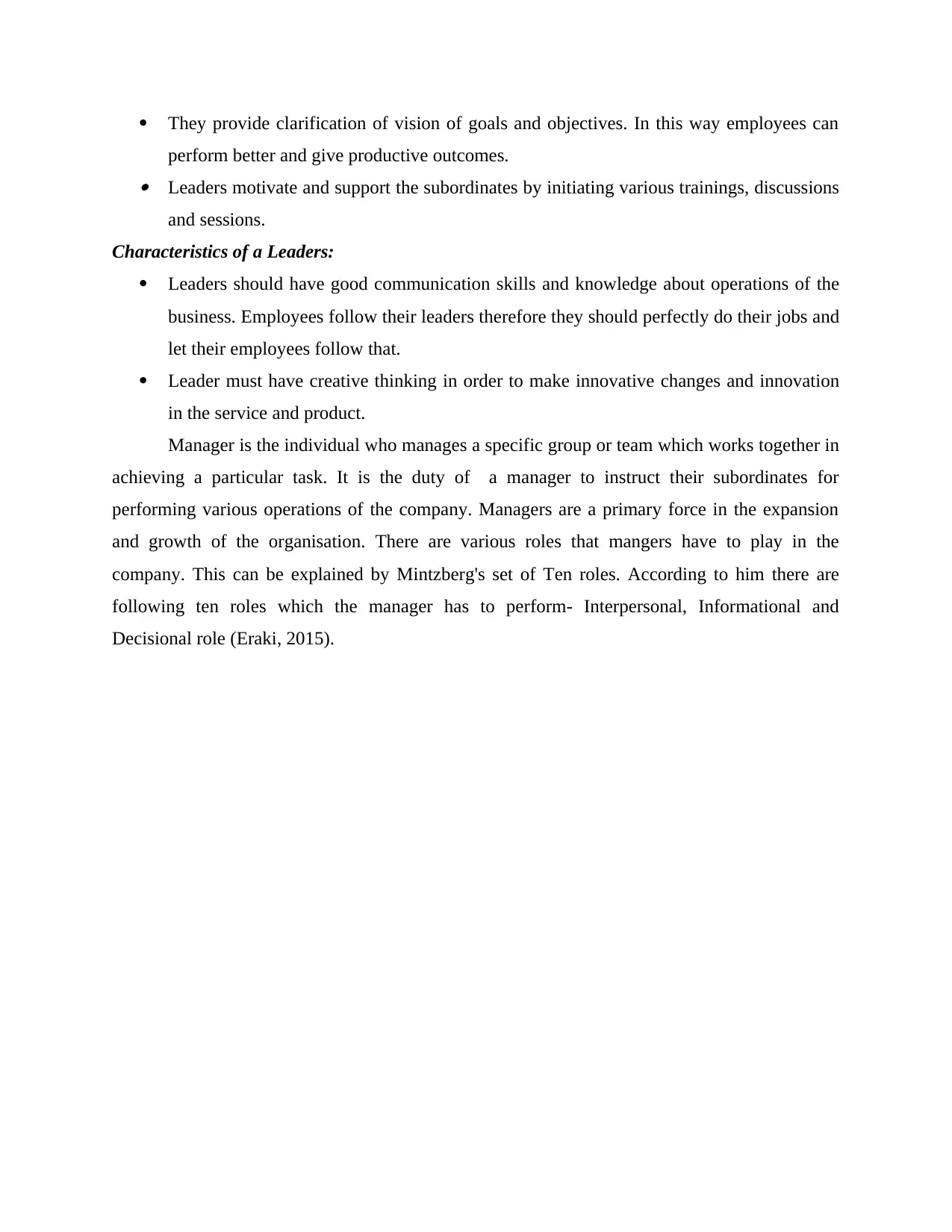
They provide clarification of vision of goals and objectives. In this way employees can
perform better and give productive outcomes. Leaders motivate and support the subordinates by initiating various trainings, discussions
and sessions.
Characteristics of a Leaders:
Leaders should have good communication skills and knowledge about operations of the
business. Employees follow their leaders therefore they should perfectly do their jobs and
let their employees follow that.
Leader must have creative thinking in order to make innovative changes and innovation
in the service and product.
Manager is the individual who manages a specific group or team which works together in
achieving a particular task. It is the duty of a manager to instruct their subordinates for
performing various operations of the company. Managers are a primary force in the expansion
and growth of the organisation. There are various roles that mangers have to play in the
company. This can be explained by Mintzberg's set of Ten roles. According to him there are
following ten roles which the manager has to perform- Interpersonal, Informational and
Decisional role (Eraki, 2015).
perform better and give productive outcomes. Leaders motivate and support the subordinates by initiating various trainings, discussions
and sessions.
Characteristics of a Leaders:
Leaders should have good communication skills and knowledge about operations of the
business. Employees follow their leaders therefore they should perfectly do their jobs and
let their employees follow that.
Leader must have creative thinking in order to make innovative changes and innovation
in the service and product.
Manager is the individual who manages a specific group or team which works together in
achieving a particular task. It is the duty of a manager to instruct their subordinates for
performing various operations of the company. Managers are a primary force in the expansion
and growth of the organisation. There are various roles that mangers have to play in the
company. This can be explained by Mintzberg's set of Ten roles. According to him there are
following ten roles which the manager has to perform- Interpersonal, Informational and
Decisional role (Eraki, 2015).
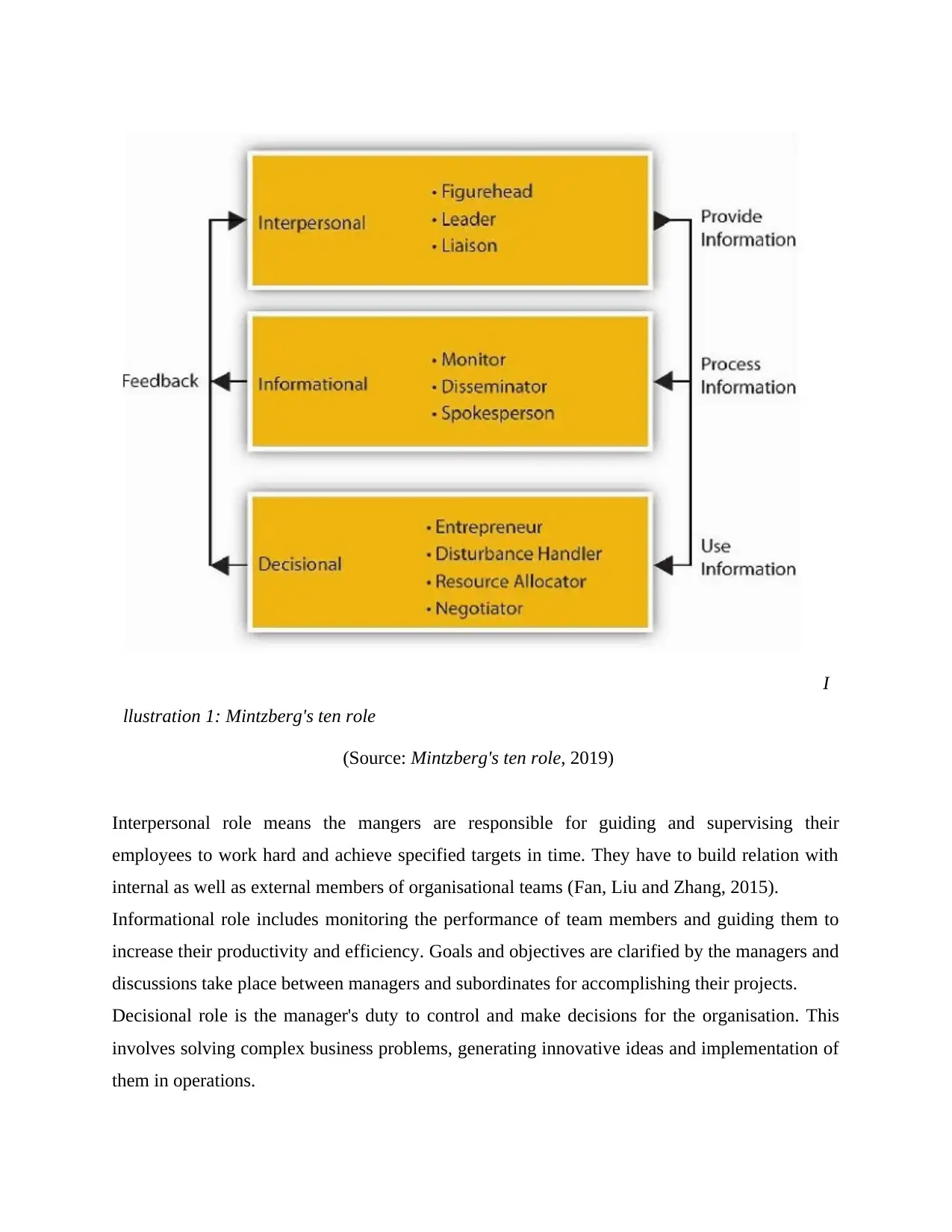
(Source: Mintzberg's ten role, 2019)
Interpersonal role means the mangers are responsible for guiding and supervising their
employees to work hard and achieve specified targets in time. They have to build relation with
internal as well as external members of organisational teams (Fan, Liu and Zhang, 2015).
Informational role includes monitoring the performance of team members and guiding them to
increase their productivity and efficiency. Goals and objectives are clarified by the managers and
discussions take place between managers and subordinates for accomplishing their projects.
Decisional role is the manager's duty to control and make decisions for the organisation. This
involves solving complex business problems, generating innovative ideas and implementation of
them in operations.
I
llustration 1: Mintzberg's ten role
Interpersonal role means the mangers are responsible for guiding and supervising their
employees to work hard and achieve specified targets in time. They have to build relation with
internal as well as external members of organisational teams (Fan, Liu and Zhang, 2015).
Informational role includes monitoring the performance of team members and guiding them to
increase their productivity and efficiency. Goals and objectives are clarified by the managers and
discussions take place between managers and subordinates for accomplishing their projects.
Decisional role is the manager's duty to control and make decisions for the organisation. This
involves solving complex business problems, generating innovative ideas and implementation of
them in operations.
I
llustration 1: Mintzberg's ten role
⊘ This is a preview!⊘
Do you want full access?
Subscribe today to unlock all pages.

Trusted by 1+ million students worldwide
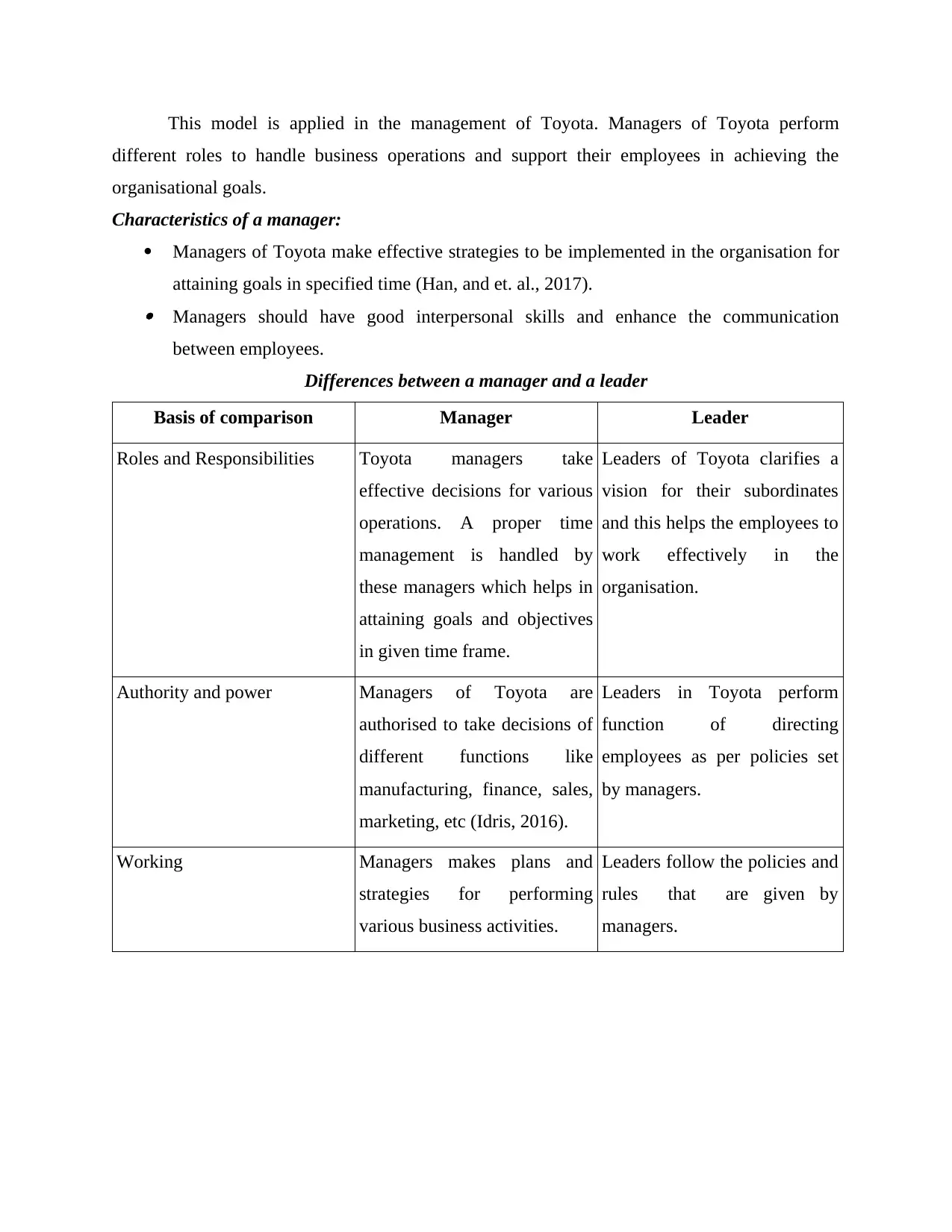
This model is applied in the management of Toyota. Managers of Toyota perform
different roles to handle business operations and support their employees in achieving the
organisational goals.
Characteristics of a manager:
Managers of Toyota make effective strategies to be implemented in the organisation for
attaining goals in specified time (Han, and et. al., 2017). Managers should have good interpersonal skills and enhance the communication
between employees.
Differences between a manager and a leader
Basis of comparison Manager Leader
Roles and Responsibilities Toyota managers take
effective decisions for various
operations. A proper time
management is handled by
these managers which helps in
attaining goals and objectives
in given time frame.
Leaders of Toyota clarifies a
vision for their subordinates
and this helps the employees to
work effectively in the
organisation.
Authority and power Managers of Toyota are
authorised to take decisions of
different functions like
manufacturing, finance, sales,
marketing, etc (Idris, 2016).
Leaders in Toyota perform
function of directing
employees as per policies set
by managers.
Working Managers makes plans and
strategies for performing
various business activities.
Leaders follow the policies and
rules that are given by
managers.
different roles to handle business operations and support their employees in achieving the
organisational goals.
Characteristics of a manager:
Managers of Toyota make effective strategies to be implemented in the organisation for
attaining goals in specified time (Han, and et. al., 2017). Managers should have good interpersonal skills and enhance the communication
between employees.
Differences between a manager and a leader
Basis of comparison Manager Leader
Roles and Responsibilities Toyota managers take
effective decisions for various
operations. A proper time
management is handled by
these managers which helps in
attaining goals and objectives
in given time frame.
Leaders of Toyota clarifies a
vision for their subordinates
and this helps the employees to
work effectively in the
organisation.
Authority and power Managers of Toyota are
authorised to take decisions of
different functions like
manufacturing, finance, sales,
marketing, etc (Idris, 2016).
Leaders in Toyota perform
function of directing
employees as per policies set
by managers.
Working Managers makes plans and
strategies for performing
various business activities.
Leaders follow the policies and
rules that are given by
managers.
Paraphrase This Document
Need a fresh take? Get an instant paraphrase of this document with our AI Paraphraser
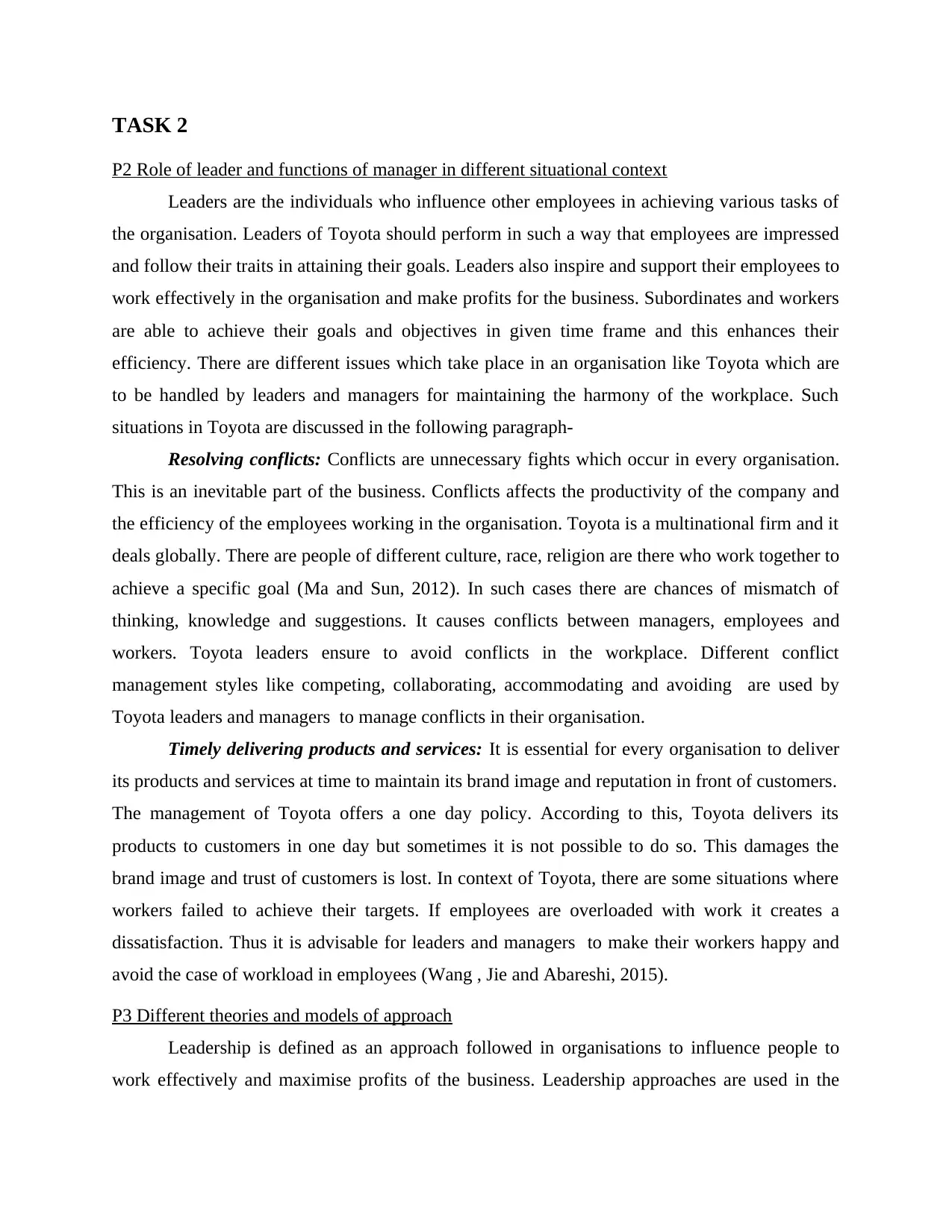
TASK 2
P2 Role of leader and functions of manager in different situational context
Leaders are the individuals who influence other employees in achieving various tasks of
the organisation. Leaders of Toyota should perform in such a way that employees are impressed
and follow their traits in attaining their goals. Leaders also inspire and support their employees to
work effectively in the organisation and make profits for the business. Subordinates and workers
are able to achieve their goals and objectives in given time frame and this enhances their
efficiency. There are different issues which take place in an organisation like Toyota which are
to be handled by leaders and managers for maintaining the harmony of the workplace. Such
situations in Toyota are discussed in the following paragraph-
Resolving conflicts: Conflicts are unnecessary fights which occur in every organisation.
This is an inevitable part of the business. Conflicts affects the productivity of the company and
the efficiency of the employees working in the organisation. Toyota is a multinational firm and it
deals globally. There are people of different culture, race, religion are there who work together to
achieve a specific goal (Ma and Sun, 2012). In such cases there are chances of mismatch of
thinking, knowledge and suggestions. It causes conflicts between managers, employees and
workers. Toyota leaders ensure to avoid conflicts in the workplace. Different conflict
management styles like competing, collaborating, accommodating and avoiding are used by
Toyota leaders and managers to manage conflicts in their organisation.
Timely delivering products and services: It is essential for every organisation to deliver
its products and services at time to maintain its brand image and reputation in front of customers.
The management of Toyota offers a one day policy. According to this, Toyota delivers its
products to customers in one day but sometimes it is not possible to do so. This damages the
brand image and trust of customers is lost. In context of Toyota, there are some situations where
workers failed to achieve their targets. If employees are overloaded with work it creates a
dissatisfaction. Thus it is advisable for leaders and managers to make their workers happy and
avoid the case of workload in employees (Wang , Jie and Abareshi, 2015).
P3 Different theories and models of approach
Leadership is defined as an approach followed in organisations to influence people to
work effectively and maximise profits of the business. Leadership approaches are used in the
P2 Role of leader and functions of manager in different situational context
Leaders are the individuals who influence other employees in achieving various tasks of
the organisation. Leaders of Toyota should perform in such a way that employees are impressed
and follow their traits in attaining their goals. Leaders also inspire and support their employees to
work effectively in the organisation and make profits for the business. Subordinates and workers
are able to achieve their goals and objectives in given time frame and this enhances their
efficiency. There are different issues which take place in an organisation like Toyota which are
to be handled by leaders and managers for maintaining the harmony of the workplace. Such
situations in Toyota are discussed in the following paragraph-
Resolving conflicts: Conflicts are unnecessary fights which occur in every organisation.
This is an inevitable part of the business. Conflicts affects the productivity of the company and
the efficiency of the employees working in the organisation. Toyota is a multinational firm and it
deals globally. There are people of different culture, race, religion are there who work together to
achieve a specific goal (Ma and Sun, 2012). In such cases there are chances of mismatch of
thinking, knowledge and suggestions. It causes conflicts between managers, employees and
workers. Toyota leaders ensure to avoid conflicts in the workplace. Different conflict
management styles like competing, collaborating, accommodating and avoiding are used by
Toyota leaders and managers to manage conflicts in their organisation.
Timely delivering products and services: It is essential for every organisation to deliver
its products and services at time to maintain its brand image and reputation in front of customers.
The management of Toyota offers a one day policy. According to this, Toyota delivers its
products to customers in one day but sometimes it is not possible to do so. This damages the
brand image and trust of customers is lost. In context of Toyota, there are some situations where
workers failed to achieve their targets. If employees are overloaded with work it creates a
dissatisfaction. Thus it is advisable for leaders and managers to make their workers happy and
avoid the case of workload in employees (Wang , Jie and Abareshi, 2015).
P3 Different theories and models of approach
Leadership is defined as an approach followed in organisations to influence people to
work effectively and maximise profits of the business. Leadership approaches are used in the
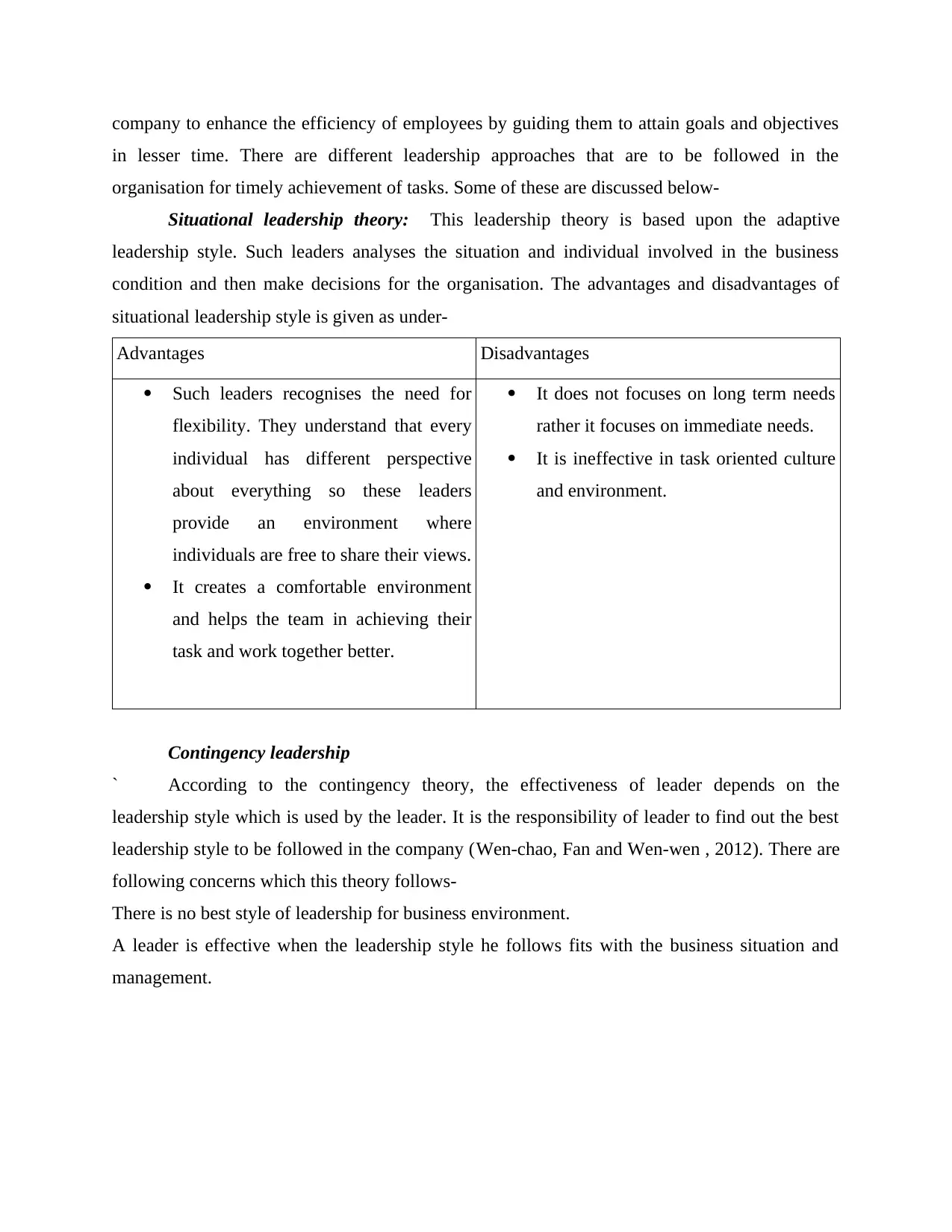
company to enhance the efficiency of employees by guiding them to attain goals and objectives
in lesser time. There are different leadership approaches that are to be followed in the
organisation for timely achievement of tasks. Some of these are discussed below-
Situational leadership theory: This leadership theory is based upon the adaptive
leadership style. Such leaders analyses the situation and individual involved in the business
condition and then make decisions for the organisation. The advantages and disadvantages of
situational leadership style is given as under-
Advantages Disadvantages
Such leaders recognises the need for
flexibility. They understand that every
individual has different perspective
about everything so these leaders
provide an environment where
individuals are free to share their views.
It creates a comfortable environment
and helps the team in achieving their
task and work together better.
It does not focuses on long term needs
rather it focuses on immediate needs.
It is ineffective in task oriented culture
and environment.
Contingency leadership
` According to the contingency theory, the effectiveness of leader depends on the
leadership style which is used by the leader. It is the responsibility of leader to find out the best
leadership style to be followed in the company (Wen-chao, Fan and Wen-wen , 2012). There are
following concerns which this theory follows-
There is no best style of leadership for business environment.
A leader is effective when the leadership style he follows fits with the business situation and
management.
in lesser time. There are different leadership approaches that are to be followed in the
organisation for timely achievement of tasks. Some of these are discussed below-
Situational leadership theory: This leadership theory is based upon the adaptive
leadership style. Such leaders analyses the situation and individual involved in the business
condition and then make decisions for the organisation. The advantages and disadvantages of
situational leadership style is given as under-
Advantages Disadvantages
Such leaders recognises the need for
flexibility. They understand that every
individual has different perspective
about everything so these leaders
provide an environment where
individuals are free to share their views.
It creates a comfortable environment
and helps the team in achieving their
task and work together better.
It does not focuses on long term needs
rather it focuses on immediate needs.
It is ineffective in task oriented culture
and environment.
Contingency leadership
` According to the contingency theory, the effectiveness of leader depends on the
leadership style which is used by the leader. It is the responsibility of leader to find out the best
leadership style to be followed in the company (Wen-chao, Fan and Wen-wen , 2012). There are
following concerns which this theory follows-
There is no best style of leadership for business environment.
A leader is effective when the leadership style he follows fits with the business situation and
management.
⊘ This is a preview!⊘
Do you want full access?
Subscribe today to unlock all pages.

Trusted by 1+ million students worldwide
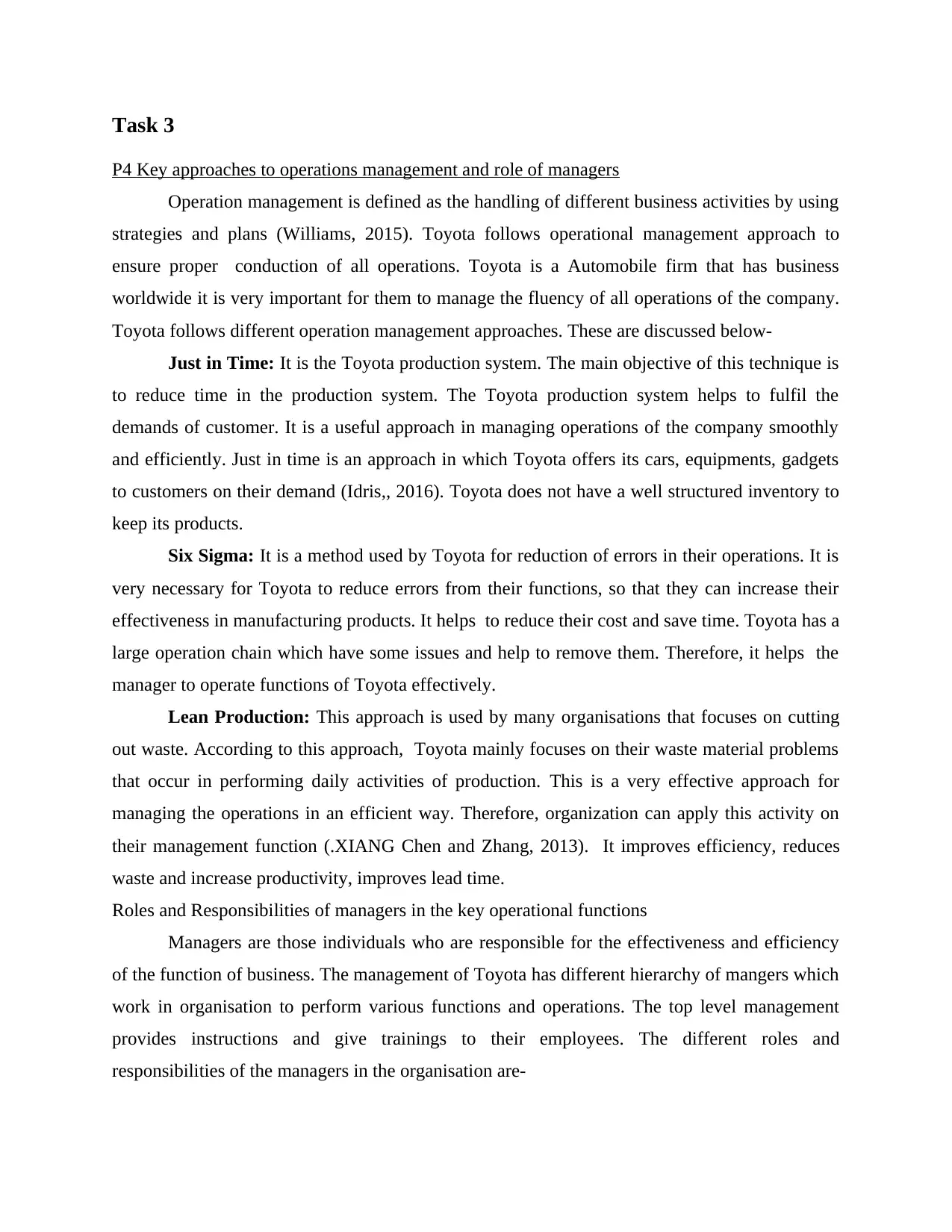
Task 3
P4 Key approaches to operations management and role of managers
Operation management is defined as the handling of different business activities by using
strategies and plans (Williams, 2015). Toyota follows operational management approach to
ensure proper conduction of all operations. Toyota is a Automobile firm that has business
worldwide it is very important for them to manage the fluency of all operations of the company.
Toyota follows different operation management approaches. These are discussed below-
Just in Time: It is the Toyota production system. The main objective of this technique is
to reduce time in the production system. The Toyota production system helps to fulfil the
demands of customer. It is a useful approach in managing operations of the company smoothly
and efficiently. Just in time is an approach in which Toyota offers its cars, equipments, gadgets
to customers on their demand (Idris,, 2016). Toyota does not have a well structured inventory to
keep its products.
Six Sigma: It is a method used by Toyota for reduction of errors in their operations. It is
very necessary for Toyota to reduce errors from their functions, so that they can increase their
effectiveness in manufacturing products. It helps to reduce their cost and save time. Toyota has a
large operation chain which have some issues and help to remove them. Therefore, it helps the
manager to operate functions of Toyota effectively.
Lean Production: This approach is used by many organisations that focuses on cutting
out waste. According to this approach, Toyota mainly focuses on their waste material problems
that occur in performing daily activities of production. This is a very effective approach for
managing the operations in an efficient way. Therefore, organization can apply this activity on
their management function (.XIANG Chen and Zhang, 2013). It improves efficiency, reduces
waste and increase productivity, improves lead time.
Roles and Responsibilities of managers in the key operational functions
Managers are those individuals who are responsible for the effectiveness and efficiency
of the function of business. The management of Toyota has different hierarchy of mangers which
work in organisation to perform various functions and operations. The top level management
provides instructions and give trainings to their employees. The different roles and
responsibilities of the managers in the organisation are-
P4 Key approaches to operations management and role of managers
Operation management is defined as the handling of different business activities by using
strategies and plans (Williams, 2015). Toyota follows operational management approach to
ensure proper conduction of all operations. Toyota is a Automobile firm that has business
worldwide it is very important for them to manage the fluency of all operations of the company.
Toyota follows different operation management approaches. These are discussed below-
Just in Time: It is the Toyota production system. The main objective of this technique is
to reduce time in the production system. The Toyota production system helps to fulfil the
demands of customer. It is a useful approach in managing operations of the company smoothly
and efficiently. Just in time is an approach in which Toyota offers its cars, equipments, gadgets
to customers on their demand (Idris,, 2016). Toyota does not have a well structured inventory to
keep its products.
Six Sigma: It is a method used by Toyota for reduction of errors in their operations. It is
very necessary for Toyota to reduce errors from their functions, so that they can increase their
effectiveness in manufacturing products. It helps to reduce their cost and save time. Toyota has a
large operation chain which have some issues and help to remove them. Therefore, it helps the
manager to operate functions of Toyota effectively.
Lean Production: This approach is used by many organisations that focuses on cutting
out waste. According to this approach, Toyota mainly focuses on their waste material problems
that occur in performing daily activities of production. This is a very effective approach for
managing the operations in an efficient way. Therefore, organization can apply this activity on
their management function (.XIANG Chen and Zhang, 2013). It improves efficiency, reduces
waste and increase productivity, improves lead time.
Roles and Responsibilities of managers in the key operational functions
Managers are those individuals who are responsible for the effectiveness and efficiency
of the function of business. The management of Toyota has different hierarchy of mangers which
work in organisation to perform various functions and operations. The top level management
provides instructions and give trainings to their employees. The different roles and
responsibilities of the managers in the organisation are-
Paraphrase This Document
Need a fresh take? Get an instant paraphrase of this document with our AI Paraphraser
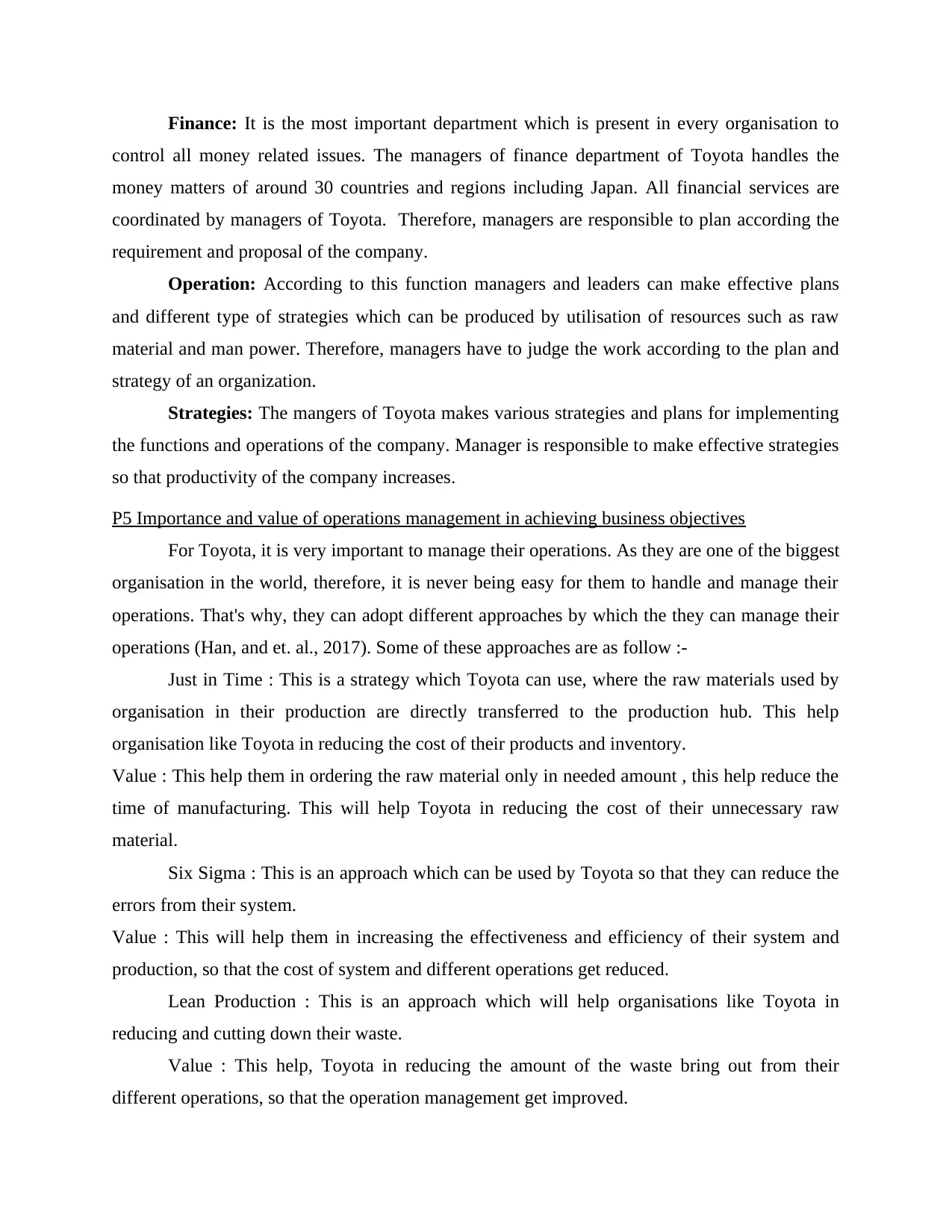
Finance: It is the most important department which is present in every organisation to
control all money related issues. The managers of finance department of Toyota handles the
money matters of around 30 countries and regions including Japan. All financial services are
coordinated by managers of Toyota. Therefore, managers are responsible to plan according the
requirement and proposal of the company.
Operation: According to this function managers and leaders can make effective plans
and different type of strategies which can be produced by utilisation of resources such as raw
material and man power. Therefore, managers have to judge the work according to the plan and
strategy of an organization.
Strategies: The mangers of Toyota makes various strategies and plans for implementing
the functions and operations of the company. Manager is responsible to make effective strategies
so that productivity of the company increases.
P5 Importance and value of operations management in achieving business objectives
For Toyota, it is very important to manage their operations. As they are one of the biggest
organisation in the world, therefore, it is never being easy for them to handle and manage their
operations. That's why, they can adopt different approaches by which the they can manage their
operations (Han, and et. al., 2017). Some of these approaches are as follow :-
Just in Time : This is a strategy which Toyota can use, where the raw materials used by
organisation in their production are directly transferred to the production hub. This help
organisation like Toyota in reducing the cost of their products and inventory.
Value : This help them in ordering the raw material only in needed amount , this help reduce the
time of manufacturing. This will help Toyota in reducing the cost of their unnecessary raw
material.
Six Sigma : This is an approach which can be used by Toyota so that they can reduce the
errors from their system.
Value : This will help them in increasing the effectiveness and efficiency of their system and
production, so that the cost of system and different operations get reduced.
Lean Production : This is an approach which will help organisations like Toyota in
reducing and cutting down their waste.
Value : This help, Toyota in reducing the amount of the waste bring out from their
different operations, so that the operation management get improved.
control all money related issues. The managers of finance department of Toyota handles the
money matters of around 30 countries and regions including Japan. All financial services are
coordinated by managers of Toyota. Therefore, managers are responsible to plan according the
requirement and proposal of the company.
Operation: According to this function managers and leaders can make effective plans
and different type of strategies which can be produced by utilisation of resources such as raw
material and man power. Therefore, managers have to judge the work according to the plan and
strategy of an organization.
Strategies: The mangers of Toyota makes various strategies and plans for implementing
the functions and operations of the company. Manager is responsible to make effective strategies
so that productivity of the company increases.
P5 Importance and value of operations management in achieving business objectives
For Toyota, it is very important to manage their operations. As they are one of the biggest
organisation in the world, therefore, it is never being easy for them to handle and manage their
operations. That's why, they can adopt different approaches by which the they can manage their
operations (Han, and et. al., 2017). Some of these approaches are as follow :-
Just in Time : This is a strategy which Toyota can use, where the raw materials used by
organisation in their production are directly transferred to the production hub. This help
organisation like Toyota in reducing the cost of their products and inventory.
Value : This help them in ordering the raw material only in needed amount , this help reduce the
time of manufacturing. This will help Toyota in reducing the cost of their unnecessary raw
material.
Six Sigma : This is an approach which can be used by Toyota so that they can reduce the
errors from their system.
Value : This will help them in increasing the effectiveness and efficiency of their system and
production, so that the cost of system and different operations get reduced.
Lean Production : This is an approach which will help organisations like Toyota in
reducing and cutting down their waste.
Value : This help, Toyota in reducing the amount of the waste bring out from their
different operations, so that the operation management get improved.
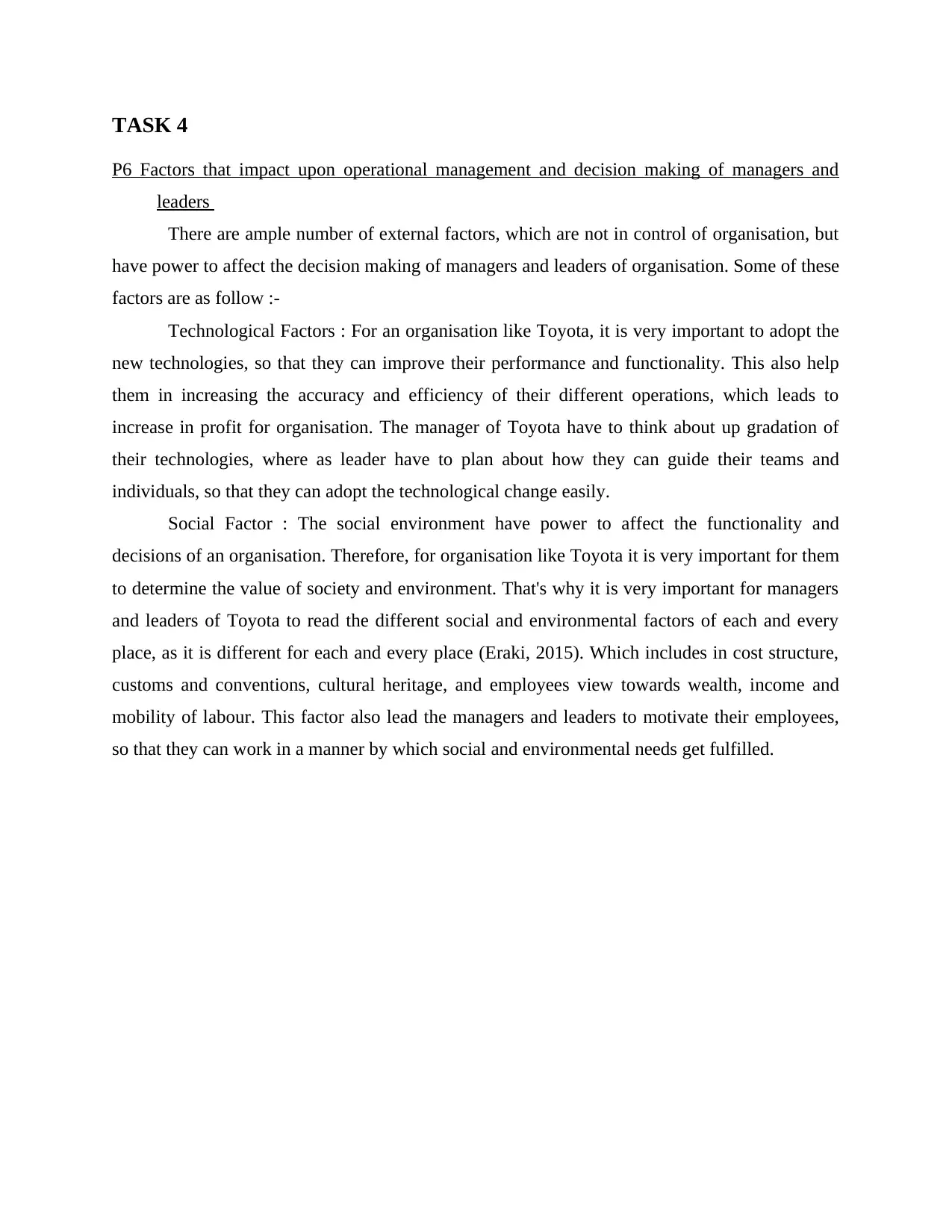
TASK 4
P6 Factors that impact upon operational management and decision making of managers and
leaders
There are ample number of external factors, which are not in control of organisation, but
have power to affect the decision making of managers and leaders of organisation. Some of these
factors are as follow :-
Technological Factors : For an organisation like Toyota, it is very important to adopt the
new technologies, so that they can improve their performance and functionality. This also help
them in increasing the accuracy and efficiency of their different operations, which leads to
increase in profit for organisation. The manager of Toyota have to think about up gradation of
their technologies, where as leader have to plan about how they can guide their teams and
individuals, so that they can adopt the technological change easily.
Social Factor : The social environment have power to affect the functionality and
decisions of an organisation. Therefore, for organisation like Toyota it is very important for them
to determine the value of society and environment. That's why it is very important for managers
and leaders of Toyota to read the different social and environmental factors of each and every
place, as it is different for each and every place (Eraki, 2015). Which includes in cost structure,
customs and conventions, cultural heritage, and employees view towards wealth, income and
mobility of labour. This factor also lead the managers and leaders to motivate their employees,
so that they can work in a manner by which social and environmental needs get fulfilled.
P6 Factors that impact upon operational management and decision making of managers and
leaders
There are ample number of external factors, which are not in control of organisation, but
have power to affect the decision making of managers and leaders of organisation. Some of these
factors are as follow :-
Technological Factors : For an organisation like Toyota, it is very important to adopt the
new technologies, so that they can improve their performance and functionality. This also help
them in increasing the accuracy and efficiency of their different operations, which leads to
increase in profit for organisation. The manager of Toyota have to think about up gradation of
their technologies, where as leader have to plan about how they can guide their teams and
individuals, so that they can adopt the technological change easily.
Social Factor : The social environment have power to affect the functionality and
decisions of an organisation. Therefore, for organisation like Toyota it is very important for them
to determine the value of society and environment. That's why it is very important for managers
and leaders of Toyota to read the different social and environmental factors of each and every
place, as it is different for each and every place (Eraki, 2015). Which includes in cost structure,
customs and conventions, cultural heritage, and employees view towards wealth, income and
mobility of labour. This factor also lead the managers and leaders to motivate their employees,
so that they can work in a manner by which social and environmental needs get fulfilled.
⊘ This is a preview!⊘
Do you want full access?
Subscribe today to unlock all pages.

Trusted by 1+ million students worldwide
1 out of 13
Related Documents
Your All-in-One AI-Powered Toolkit for Academic Success.
+13062052269
info@desklib.com
Available 24*7 on WhatsApp / Email
![[object Object]](/_next/static/media/star-bottom.7253800d.svg)
Unlock your academic potential
Copyright © 2020–2025 A2Z Services. All Rights Reserved. Developed and managed by ZUCOL.





